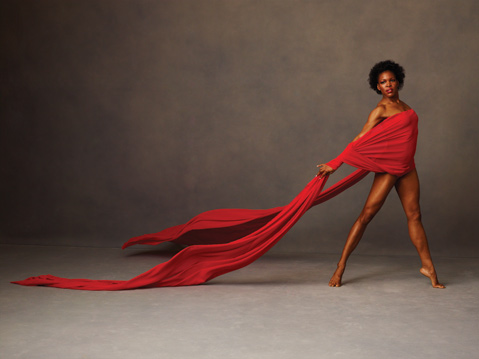Alvin Ailey Returns to S.B.
World-Class Company Brings Two Distinct Programs

In 1958, a young African-American dancer and choreographer named Alvin Ailey founded a concert dance company in New York City. Fifty-five years later, that company has grown into one of the world’s most renowned performing arts groups, as well as an icon of American culture. This weekend, Alvin Ailey American Dance Company returns to Santa Barbara, courtesy of UCSB Arts & Lectures. The company is led by Robert Battle, who in 2011 succeeded longtime artistic director Judith Jamison. Last week, Battle spoke to me about the program he’ll bring to Santa Barbara and his vision of the Ailey legacy.
You’re bringing a number of newer works this time. Tell me about Kyle Abraham’s “Another Night.” Kyle is a very successful choreographer who is getting lots of rave reviews, awards, and commissions. I love his sensibility: an urban edge with a modern-dance sensibility. I wanted him to set a work on the company because I admired his sense of narrative, the inventiveness of his movement, and the intelligence of his compositions. “Another Night” is set to Dizzy Gillespie’s “A Night in Tunisia.” This version is played by Art Blakey from Pittsburg. Kyle wanted to celebrate something having to do with the flair and energy of that city. In this work, much like in the bebop era, you get this sense of improvisation, polyrhythm, and syncopation.
You’re also bringing Paul Taylor’s “Arden Court” from 1981. What made you decide to bring that classic work of American modern dance into the company repertory? Paul Taylor is a genius, and “Arden Court” is a wonderful work. What I love about the composition is the beautiful adagio section that happens close to the end of the ballet. It’s so subtle and minimalist, and I thought it would be wonderful to see my dancers do that. The thing I love, too, is when the curtain finally opens after a kind of prelude you see this beautiful backdrop of a rose, and I thought, What a wonderful way to open my first season as Artistic Director.
Do you ever go back to watch old video footage of the company, and if so, how does that inform you? I’m a person who loves looking back. There’s a wonderful version of Mr. Ailey himself doing “Sinner Man” from Revelations. I watch that film, and I don’t say to my dancers, “Do it like that,” because things evolve — they have to evolve. But I love thinking, what could those dancers have been thinking at the time, and could Mr. Ailey have known that the company would be such a tremendous beacon for the country and the world? I sort of look at those dancers on the old films and think of them looking out into the audience and the company’s future, and I wonder what they saw, back when they were dealing with their own costumes and riding in station wagons. To look at where we are now and realize the shoulders we are standing on — it’s centering and humbling.
In the earlier Ailey works, religious and spiritual experience was central. How do you think that emphasis has changed or evolved? I think it was always about spirit, and about finding spirit in everything that we do. When I look at newer works like Jiří Kylián’s “Petite Mort,” say, I think that along with the brilliance of the movements and the brilliance of the dancers and the technical virtuosity, we still dance with that sense of being spirit-filled. I think that’s the company’s intention from those early works, and Mr. Ailey’s spirit is very much still in the house. I always remember that the company was built out of a political statement as well as an artistic one, and that is always part of how I view the works I bring into the repertory. I always ask, “How does this work reflect the impetus of the company?”
What do you think having a dedicated space like the Joan Weill Center for Dance has done for the company? It’s a center for dance that also represents an investment in the arts that you can see and touch. I think the building shows that the performing arts are important — that the company is important to this country and to the world. When you see an edifice of that magnitude, people take it seriously. There’s something about it that says, “Wow, this is amazing.” The building is all glass, so people are always looking in, and wanting to get involved. There are now thousands of people registered to take classes through our extension program. It brings the community together.
Do you think that prominence and exposure gives Ailey responsibility to the larger dance community? Yes. One of the first things I did when I started was that I launched the New Directions Choreography Lab, which addressed the need for choreographers to have time and space to create, and a safe place to fail. We choose four choreographers each year. They get seven weeks of creative time, and a decent stipend. They also get an artistic advisor or mentor — we’ve had people like Lar Lubovitch, Gus Solomons Jr., and Elizabeth Keen — real luminaries who give constructive feedback. I wanted it to be a process where the artists don’t have to come out with a product. And I hope people copy that, because we have to address the need for time and space to experiment.
4•1•1
UCSB Arts & Lectures brings Alvin Ailey American Dance Theater to the Arlington Theatre for two different programs, Saturday, April 13, at 8 p.m. and Sunday, April 14, at 2 p.m. For tickets, call 893-3535 or visit artsandlectures.sa.ucsb.edu. Arts & Lectures and the Santa Barbara Dance Alliance offer a master class with the company on Friday, April 12, at 5:30 p.m. For more information or to reserve a spot, call 966-6950 or visit sbdancealliance.org.



